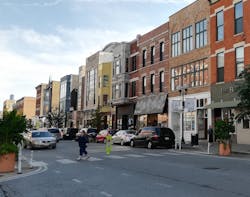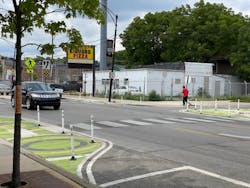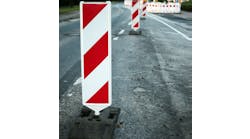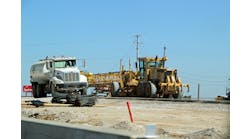Vision Zero program makes quick and effective changes to roads for traffic safety
In 2016, the City of Chicago adopted the ambitious goal of Vision Zero—eliminating all traffic fatalities and serious injuries.
Since the initial commitment and the subsequent release of the city’s Vision Zero Action Plan in 2017, the city is changing roadway design, implementing policy, and targeting education to make streets and the city safer.
Vision Zero Chicago is led by the Mayor’s Office and Chicago DOT (CDOT), in coordination with multiple city departments and community partners.
Vision Zero exercises a safe systems approach where human life is the foremost consideration when designing a road; it accepts that people can make mistakes, but these mistakes should not lead to death or severe injury. The safe systems approach examines how infrastructure, new technologies, and comprehensive policies can protect people as they move throughout the city.
In 2018, CDOT developed a High Crash Corridor Framework Plan to organize upgrades to roadway design. The plan includes guidelines for infrastructure improvements on the 70 miles of High Crash Corridors (HCCs)—streets identified to have higher concentrations of severe traffic crashes. Understanding that one solution cannot fit all the street types, the plan recommends varying degrees of design interventions from the quickest and lowest cost to the most expensive and time intensive: rapid delivery projects (RDP), capital improvements, and street transformations. Over the past three years, CDOT has installed RDPs on multiple corridors throughout the city as recommended by the HCC Framework Plan.
Rapid Delivery Projects (RDPs) Definition
Rapid Delivery Projects are low-cost and fast. RDPs entail changes to the street that can be implemented in six months or less using interim materials such as pavement markings, colored paint and pavement treatments, flexible delineators, changes to signage or traffic signal timing, and/or changes to the speed limit.
In addition to their expedited timelines, RDPs cost significantly less than similar permanent improvements. For example, curb extensions, which increase pedestrian safety by making the people walking more visible to drivers, when installed as part of an RDP with colored pavement markings and delineators can cost around $3,000. This compares to approximately $30,000 needed to build a similar curb extension in concrete. The significant cost difference allows the city to fund the RDPs locally or from existing budgets. Because these projects almost exclusively use surface treatments such as paint, their impact on utility infrastructure is minimal, expediting the design process and approvals. RDPs are typically designed in-house and often incorporated into existing contracts.
Rapid Delivery Projects are an interim solution. RDPs are an interim solution and a way to quickly address safety issues within six months or less. Following completion, the city collects data and evaluates RDPs for effectiveness in improving safety. If the RDP is successful, the improvements can be made permanent in materials like concrete through future infrastructure projects including scheduled resurfacing.
Rapid Delivery Projects are flexible. Because they use low-cost materials, RDPs can be adjusted to maximize safety and operational benefits. CDOT seeks feedback from community members, elected officials, and other community entities before and after the installation of RDPs. Based on feedback and evaluation results, a project’s design can be modified or slated for permanent installation when funding is available.
Rapid Delivery Projects Toolbox
Typical components of a Rapid Delivery Project include:
- Curb extensions—Paint and post curb extensions use pavement markings and flexible delineators to designate space for pedestrians at intersections. They reduce crossing distances, slow turning speeds, increase pedestrian visibility, and prevent illegal parking near crosswalks.
- Hardened centerlines and rubber median bumps—Left turns can be dangerous, particularly in dense areas where large numbers of people are walking, biking, and driving. Drivers making left turns often cut corners, and the car frame can block the driver’s view of pedestrians in the crosswalk. Installing flexible posts and rubber bumps can better define the centerlines of the roadway, forcing drivers to slow down while making left turns and discouraging cutting corners.
- Crosswalk striping—Additional crosswalk markings are installed to better match the desired paths that people use naturally. As a result, people driving see the crosswalk and expect pedestrians along these paths and people walking can reach destinations more directly.
- Signal timing changes—Leading pedestrian intervals (LPI) give pedestrians a head start for crossing an intersection before drivers, improving the visibility of pedestrians in the crosswalk. A lagging left turn is a signal timing sequence in which vehicles get a left-turn arrow at the end of the cycle, providing pedestrians the chance to cross at the beginning of a signal cycle and reducing conflicts.
- Adding bike infrastructure—Striping bike lanes or adding bike turn boxes creates designated space on the roadway for people biking. Additionally, flexible delineators can be added to better delineate space for cyclists and increase their comfort while biking.
- Policy changes—In addition to installing physical improvements, the Rapid Delivery Projects include policy changes that improve road safety for all users. With every RDP, the city investigates whether to lower the posted speed limit or implement turning restrictions at intersections (e.g., no right turns at red lights). Lower speeds enable drivers to stop more quickly, see more of their surroundings, and improve the visibility of other road users, including vulnerable users like older adults, children, and people walking or biking.
Recent Rapid Delivery Project Highlights
Milwaukee Avenue High Crash Corridor Project:
CDOT implemented RDP changes to Milwaukee Avenue, a designated Vision Zero HCC, between Western Avenue and Division Street in the summer of 2017. The improvements included striped bike facilities, curb extensions, closing right turn slip-lanes, crosswalk striping changes, and a 20 mph posted speed limit. An evaluation of the project found that:
- 52% fewer people biked in the “door zone,” the segment of the street where people exiting parked cars are likely to open their door and potentially hit a person biking.
- 42% fewer drivers failed to stop for pedestrians in uncontrolled crosswalks.
- 43% fewer people drove above 30 MPH.
The Milwaukee Avenue project was designed and funded through a partnership between the local aldermen and Special Service Area, which serves as a chamber of commerce. Since the successful installation of the project, CDOT made a right turn slip-lane closure permanent as part of a federally funded resurfacing project.
State Street High Crash Corridor Project:
CDOT also implemented RDP changes on State Street, an HCC and a major commercial corridor with heavy pedestrian activity located in Chicago’s Central Business District. In fall 2019, CDOT installed paint and post curb extensions, refuge islands, crosswalk striping changes, and hardened centerlines at six intersections along the corridor. These infrastructure changes were made in consultation with area stakeholders, including the elected officials representing the community. The CDOT Vision Zero team collected extensive data before the project was implemented including vehicle speeds, vehicle turning radii, and pedestrians remaining in the crosswalk after the signal changes. Data collection after the project installation and analysis of results is forthcoming.
INVEST South/West RDP Installations:
While most RDPs have been installed along HCCs, CDOT has begun using this project format to implement improvements throughout the city. In Spring 2020, CDOT designed and installed rapid delivery curb extensions at five intersections along Chicago Avenue, an area designated as a priority corridor by the city as part of the INVEST South/West economic development initiative.
The INVEST South/West initiative is designed to direct investment toward 10 neighborhoods on Chicago’s South and West sides. CDOT consulted with community leaders along Chicago Avenue in the city’s Austin neighborhood to select intersections near community assets that had persistent safety concerns. In addition to creating pedestrian space, the rapid delivery curb extensions incorporated art chosen by community members to reflect the local culture. Using the Rapid Delivery Project approach, these improvements went from conception to installation in three months.
The Future of RDPs in Chicago
CDOT is pursuing an RDP program that blends artistic designs with traffic calming to provide safe roadway designs that feel inviting and help activate public spaces. The expanded RDP program will allow all neighborhoods across the city, regardless of resources, to incorporate colorful street markings that improve safety.
Chicago will continue installing RDPs across the city at locations with traffic safety concerns. Rather than pursuing improvements at one-off locations, the RDPs will continue to target corridors with physical improvements and policy changes, such as lowered speed limits or no right turn on red, as implemented on Milwaukee Avenue. RDPs are an effective and efficient way to implement infrastructure improvements more quickly for the most vulnerable users of a street. Chicago will continue to expand this design strategy to make streets safer and more comfortable for residents and visitors throughout the city.




